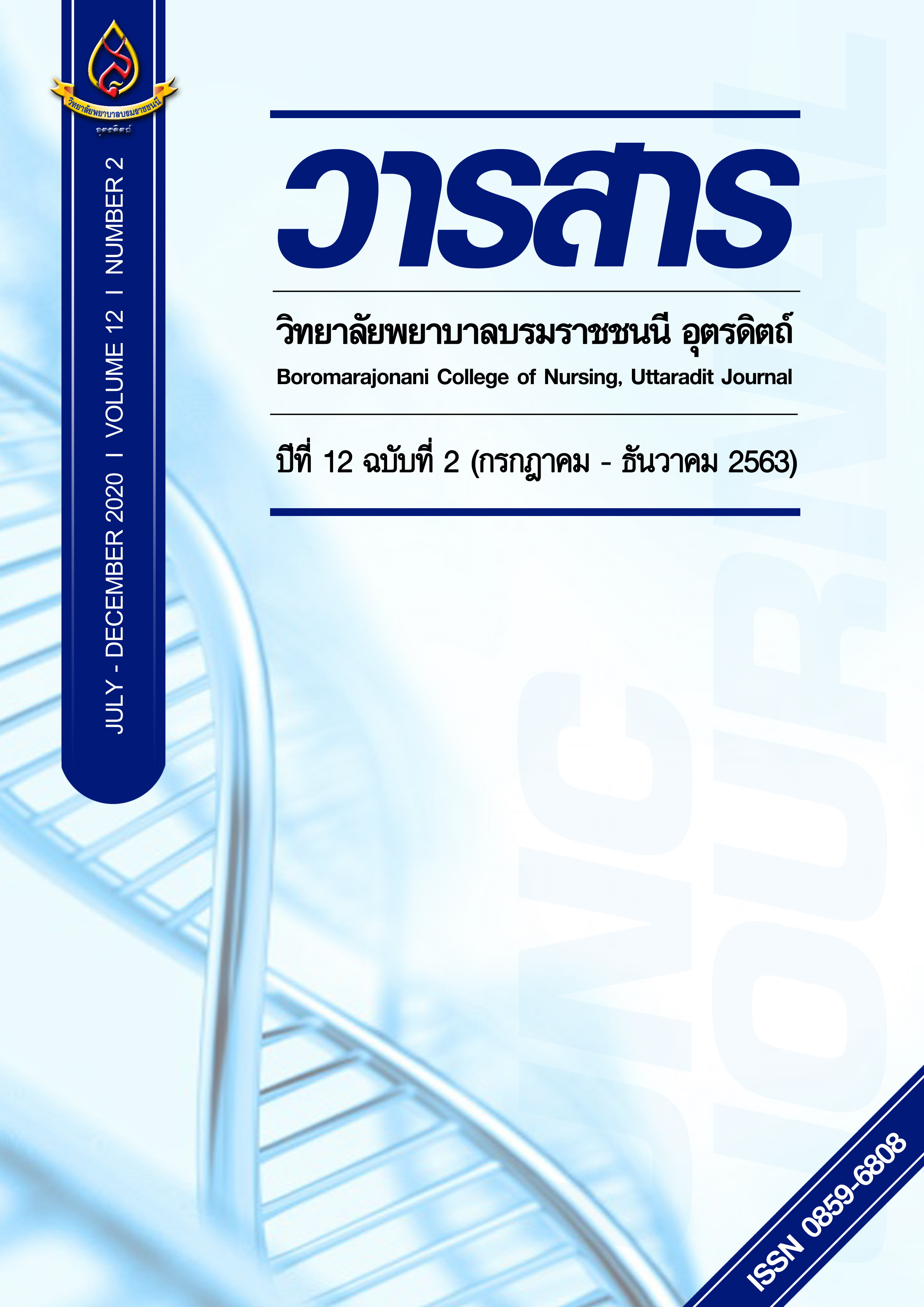ความรอบรู้ด้านการใช้ยาอย่างสมเหตุผลของอาสาสมัครสาธารณสุขประจำหมู่บ้าน
Main Article Content
บทคัดย่อ
การใช้ยาปฏิชีวนะอย่างไม่เหมาะสมหรือในขนาดต่างเกินไป หรือมากเกินจำเป็นส่งผลให้เกิดการพัฒนาการดื้อยาของเชื้อโรค การวิจัยกึ่งทดลองนี้เพื่อศึกษาเปรียบเทียบค่าเฉลี่ยความรอบรู้ด้านการใช้ยาอย่างสมเหตุผลของอาสาสมัครสาธารณสุขประจำหมู่บ้าน (อสม.) ก่อนและหลังได้รับการอบรม กลุ่มตัวอย่างเป็น อสม. ตำบลดอนแก้ว อำเภอแม่ริม จังหวัดเชียงใหม่ จำนวน 50 คน เครื่องมือที่ใช้เป็นแบบประเมินความรอบรู้ด้านการใช้ยาอย่างสมเหตุผลของประชาชนทั่วไป วิเคราะห์ข้อมูลโดยใช้สถิติพรรณนาและสถิติทดสอบที (Dependent-t-test) ผลการวิจัยพบว่า 1) ค่าเฉลี่ยคะแนนความรอบรู้ด้านการใช้ยาอย่างสมเหตุผลของ อสม. หลังการอบรมสูงกว่าก่อนอบรมอย่างมีนัยสำคัญทางสถิติที่ระดับ .05 2) ค่าเฉลี่ยคะแนนความรอบรู้ด้านการใช้ยาอย่างสมเหตุผลของ อสม. ด้านความเข้าใจเกี่ยวกับข้อมูลและบริการยาและด้านการวิเคราะห์หลังการอบรมสูงกว่าก่อนอบรมอย่างมีนัยสำคัญทางสถิติที่ระดับ .01 3) ค่าเฉลี่ยคะแนนความรอบรู้ด้านการใช้ยาอย่างสมเหตุผลของ อสม. ด้านความสามารถในการเข้าถึงแหล่งข้อมูลและบริการสุขภาพที่น่าเชื่อถือ และด้านความสามารถในการสื่อสารข้อมูลสารสนเทศและความสามารถในการสื่อสารกับสังคมหลังการอบรมสูงกว่าก่อนอบรมอย่างมีนัยสำคัญทางสถิติที่ระดับ .05 และ 4) ค่าเฉลี่ยคะแนนความรอบรู้ด้านการใช้ยาอย่างสมเหตุผลของ อสม. ด้านการประเมินข้อมูลที่ค้นพบเพื่อการตัดสินใจใช้ยาอย่างสมเหตุสมผลพบว่าความรอบรู้ก่อนและหลังการอบรมไม่แตกต่างกัน
ผลการศึกษาสามารถนำแนวคิดไปใช้ในการพัฒนาศักยภาพของ อสม. เรื่องการใช้ยาอย่างสมเหตุผล ในระยะต่อไปเพื่อให้เหมาะสมตามบริบทของพื้นที่อย่างแท้จริง
Article Details
บทความหรือข้อคิดเห็นใดใดที่ปรากฏในวารสารวิจัยการพยาบาลและวิทยาศาสตร์สุขภาพ เป็นวรรณกรรมของผู้เขียน ซึ่งบรรณาธิการหรือสมาคมศิษย์เก่า ไม่จำเป็นต้องเห็นด้วย และบทความที่ได้รับการตีพิมพ์เผยแพร่ถือเป็นลิขสิทธิ์ของวารสารวิจัยการพยาบาลและวิทยาศาสตร์สุขภาพ
เอกสารอ้างอิง
2) Chidnayee,S., Watanakul, S.,Phormpayak,D., Yottavee,W. & Kooariyakul, A. (2020). Effect of cognitive apprenticeship’s instruction on nursing process’s ability of nursing students. Boromarajonani College of Nursing, Uttaradit Journal,12(1),76-91. (in Thai).
3) Department of Health Service Support, Ministry of Public Health. (2018). Announcement of the committee for promotion and support of public health volunteers in the central village: principles, procedures and conditions for grouping of village health volunteers 2019 (2018, 20 June). Royal Thai Government Gazette 135 (Special 124), 23-25. (in Thai).
4) Drug and Medical Supply Information. (2016). Health administration division. Center Ministry of Public Health. Retrieved (2020, April 9)
from http://dmsic.moph.go.th/index/detail/6849 (in Thai).
5) Food and Drug Administration, Ministry of Public Health. (2018). Order of the food and drug administration NO. 242/2561. (in Thai).
6) Health Education Division, Department of Health Service Support. (2018). Promoting and assessing health literacy and health behavior. Revised Edition 2018. Health Education Division. Department of Health Service Support, Ministry of Public Health. Retrieved (2020, April 9) from http://www.hed.go.th/linkhed/file/575. (in Thai).
7) Holloway KA, & van Dijk L. (2011). The world medicines situation 2011 (3rd ed.), Rational use of medicines. World Health Organization, Geneva, Switzerland: 2011. Retrieved (2020, April 9) from: http://www.who.int/medicines/areas/policy/world_medicines_situation/en/index.html.
8) Komwong, D. & Sangkhawat, T. (2012). Factors affecting drug use behaviors of Village Health Volunteers. Thai Pharmaceutical and Health Science Journal, 7(3), 121-126. (in Thai).
9) Kukkong, P., Iamnirum, T., & Boonsiripan, M. (2015). Health communication competency of Village Health Volunteers in Khon Kaen Province. The Golden Teak: Humanity and Social Science Journal, 21(2), 189-197. (in Thai).
10) PaitoonNeramit, M. & Amphairit, P. (2018). Health Literacy: HL (Rational drug use for health volunteer). Health education division. Department of Health Service Support, Ministry of Public Health. Retrieved (2020, April 9) from http://www.hed.go.th/linkhed/file/713 (in Thai).
11) Primary Health Care Division. (2014). The four-decade development of primary health care in Thailand. Bangkok: The war veterans organization of Thailand under royal patronage of his majesty the king. (in Thai).
12) Nutbeam, D. (2008). Health literacy and adolescents: A framework and agenda for future research. Health Education Research. 23(5). Published by Oxford University Press.
13) Rojanavipat, K. (2019). Government inspection and supervision report regional health 1. First assessment. Fiscal year 2019. (in Thai).
Sub-Committee on the Promotion of Rational Drug Use. (2015). Rational drug use in hospital manual. Bangkok: The publishing house of agricultural cooperatives. (in Thai).
14) Sararuk, M. (2010). Empowerment of village health volunteers (VHV). Journal of Ubon Ratchathani university. 12(2), 39-48. (in Thai).
15) Thai Health Promotion Foundation. (2018). Thais have to understand not to use drugs unnecessary. Retrievedv (2020, April 9)
from https://www.thaihealth.or.th/Content/42673 -ใช้ยาสมเหตุผลคนไทยต้องเข้าใจไม่ใช้ยาเกินจำเป็น.html (in Thai).
16) Thepin,K., Moolsart,S. & Jantacumma, N. (2019). Effectiveness of a health literacy developmental program in patients with uncontrolled hypertension. Boromarajonani College of Nursing, Uttaradit Journal,11(2),197-212. (in Thai).
17) Thochu, S. & Muenpa, R. (2017). Outcomes of the program on rational drug use hospital in Nonghong District, Buriram. Thai journal of Pharmacy Practice. 9(2), 463-474. (in Thai).
18) Thongchai, C & Boonjarut, S. (2017). Capacity adaptation of Village Health Volunteers under changing contexts in the semi-urban area of Ban ThaBo, Chae Ramae Sub-district, Ubon Ratchathani Province. Area Based Development Research Journal, 9(3), 206-220. (in Thai).
19) Witayapichetsakul, S. & Sitthiboot, A. (2014). Drug use behavior of village health volunteer ao bo kwangthong sub-district, bothong district, Chonburi province. The Public Health Journal of Burapha University, 9(1), 117-128. (in Thai).
20) World Health Organization [WHO]. (2009). Medicines use in primary care in developing and transitional countries: fact book summarizing results from studies reported between 1990 and 2006. Geneva, World Health Organization.


